Arm's New Cortex-A77 CPU Micro-architecture: Evolving Performance
by Andrei Frumusanu on May 27, 2019 12:01 AM EST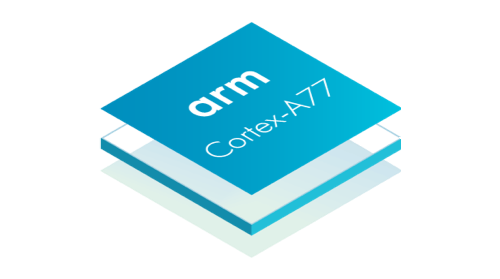
2018 was an exciting year for Arm’s own CPU designs. Last year in May we saw the release of the Cortex-A76 and the subsequent resulting silicon in the form of the Kirin 980 as well as Snapdragon 855 SoCs. We were very impressed by the IP, and Arm managed to deliver on all its performance, efficiency and area promises, resulting in some excellent SoCs and devices powering most of 2019’s flagship devices.
This year we follow-up with another TechDay disclosure, and this time around we’re uncovering Arm’s follow-up to the Cortex-A76: the new Cortex-A77. The new generation is a direct evolution of last year’s major microarchitecture introduction, and represents the second instance of Arm’s brand-new Austin core family. Today we’ll analyse how Arm has pushed the IPC of its new microarchitecture and how this will translate into real performance for upcoming late-2019/early-2020 SoCs and devices.
Deimos turns to Cortex-A77
The announcement of the Cortex-A77 doesn’t come as a surprise as Arm continues on their traditional annual IP release cadence. In fact today is not the first time that Arm has talked about the A77: In August of last year Arm had teased the CPU core when releasing its performance roadmap through 2020:
Codenamed as “Deimos”, the new Cortex-A77 picks up where the Cortex-A76 left off and follows Arm’s projected trajectory of delivering a continued solid 20-25% CAGR of performance uplift with each generation of Arm’s new Austin family of CPUs.
Before we dwell into the new Cortex-A77, we should take a look back at how the performance of the A76 has evolved for Arm:
The A76 has certainly been a hugely successful core for Arm and its licensees. The combination of the brand-new microarchitecture alongside the major improvements that the 7nm TSMC process node has brought some of the biggest performance and efficiency jumps we’ve ever seen in the industry.
The results is that the Kirin 980 as well as the Snapdragon 855 both represented major jumps over their predecessors. Qualcomm has proclaimed a 45% leap in CPU performance compared to the previous generation Snapdragon 845 with Cortex-A75 cores, the biggest generational leap ever.
While the performance increase was notable, the energy efficiency gains we saw this generation was even more impressive and directly resulted in improved battery life of devices powered by the new Kirin and Snapdragon SoCS.
While the A76 performed well, we should remember that it does have competition. While Samsung’s own microarchitecture this year with the M4 has lessened the performance/efficiency gap, the Exynos CPU still largely lags behind by a generation, even though this difference is amplified by a process node difference this year (8nm vs 7nm). The real competition for Arm here lies with Apple’s CPU design teams: Currently the A11 and A12 still hold a large performance and efficiency lead that amounts to roughly two microarchitecture generations.
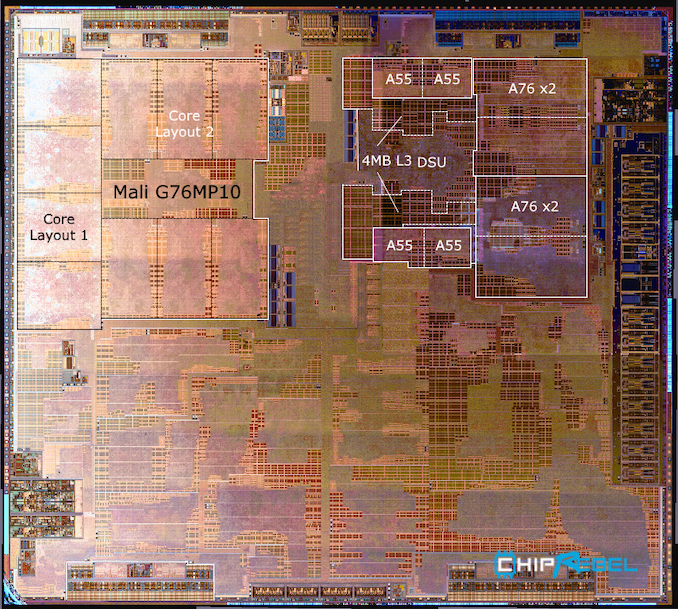
Die shot credit: ChipRebel - Block labelling: AnandTech
One of Arm’s fortes however remains in delivering the best PPA in the industry. Even though the A76’s performance didn’t quite match Apple’s, it managed to achieve outstanding efficiency with incredibly small die area sizes. In fact, this is a conscious design decision by Arm as power efficiency and area efficiency are among the top priorities for Arm’s licensees.
The Cortex-A77: A Top-Level Overview
The Cortex-A77 being a direct microarchitectural successor to the A76 means the new core largely stays in line with the predecessor’s features. Arm states that the core was built in mind with vendors being able to simply upgrade the SoC IP without much effort.
In practice what this means is that the A77 is architecturally aligned with its predecessor, still being an ARMv8.2 CPU core that is meant to be paired with a Cortex-A55 little CPU inside of a DynamIQ Shared Unit (DSU) cluster.
Fundamental configuration features such as the cache sizes of the A77 also haven’t changed compared to its predecessor: We’re still seeing 64KB L1 instruction and data caches, along with a 256 or 512KB L2 cache. It’s interesting here that Arm did design the option for an 1MB L2 cache for the infrastructure Neoverse N1 CPU core (Which itself is derived from the A76 µarch), but chooses to stay with the smaller configuration options on the client (mobile) CPU IP.
As an evolution of the A76, the A77 performance jump as expected won’t be quite as impressive, both from a microarchitecture perspective, but also from an absolute performance standpoint as we’re not expecting large process node improvements for the coming SoC generation.
Here the A77 is projected to still be productised on 7nm process nodes for most customers, and Arm is proclaiming a similar 3GHz peak target frequency as its predecessor. Naturally since frequency isn’t projected to change much, this means that the core’s targeted +20% performance boost can be solely attributed to the IP’s microarchitectural changes.
To achieve the IPC (Instructions per clock) gains, Arm has reworked the microarchitecture and introduced clever new features, generally beefing up the CPU IP to what results in a wider and more performant design.



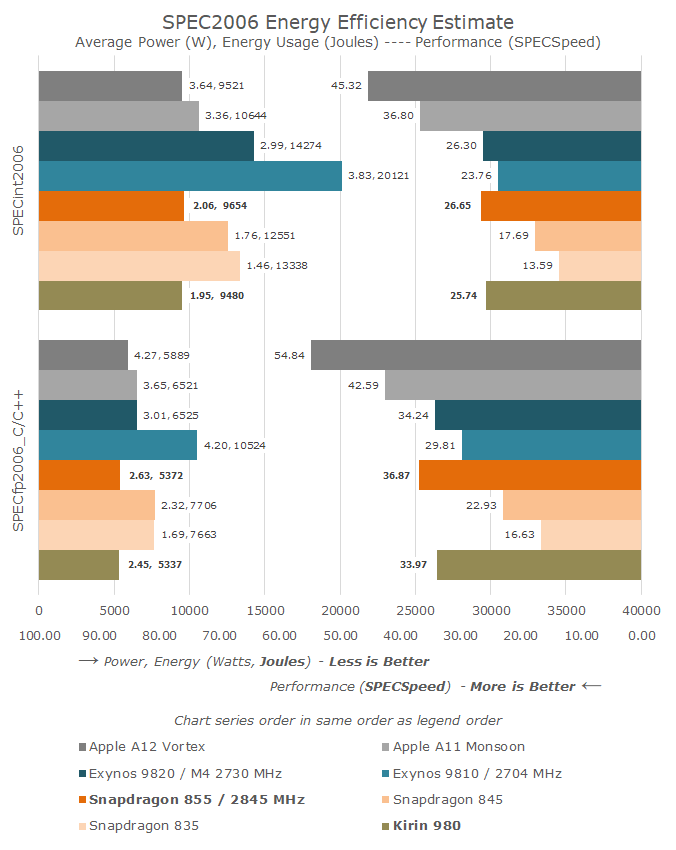
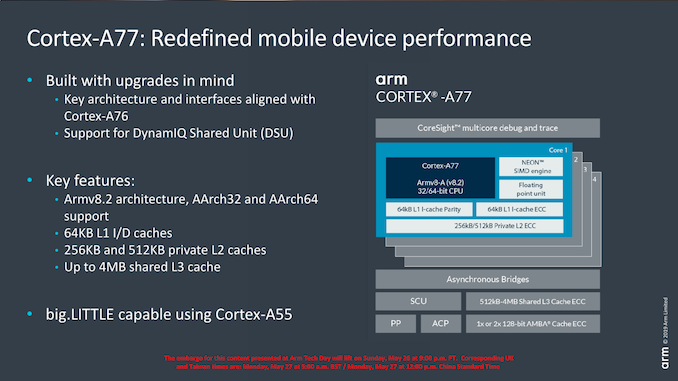
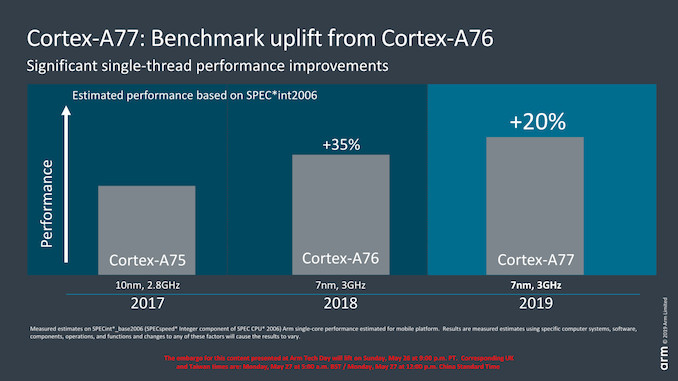








108 Comments
View All Comments
Retycint - Wednesday, May 29, 2019 - link
This isn't 2012 anymore. A 30% better performance (for instance) isn't going to lead to any real world differences, especially given the fact that most consumers use their phones as a camera/social media machinejackthepumpkinking6sic6 - Thursday, May 30, 2019 - link
How foolish to actually sit there and act as if that's the only option. First of not only are those not the only high end option but they clearly said lower cost. Meaning any segment. Even mid and low range. Use your brain before commenting.Not to mention that despite being similarly priced and having insignificantly different benchmark scores those devices are overall better and more worthy the price.... Though none are worthy of such prices. Just some are more worth it than others.
alysdexia - Monday, December 30, 2019 - link
performance -> speedAnandtech never explain how they get their power figures; I saw one mention of regression testing under the iPhone XS review but still no work. The figures look more like shared power or peak power than average CPU power as they conflict with general runtime or battery drain tests which suggest 2 watts sustained; I recently took Notebookcheck's loads of power figures to revise my list of the thriftiest CPUs where I found the equivalent TDP somewhere between the load and idles and implied screen, GPU, and memory powers; another way to estimate is to subtract the nonCPU from the power adapter rating which for iPhones is 5W, screen 1W to 2W. I had to throw out Anandtech's SPEC2006 powers.
Androids do not get thriftier chips; iPhones idle better than the average (Use the comparison tool under any Notebookcheck review) and their huge cache seems to save power. (iPhone 11 has 33MB vs. S10 5MB. This makes A13 over 4fold as good as 9820.)
W CPU/(CPU+GPU): select core–unit CPUmark [mobile/60] (Gn/s) {Mp/s/10; LZMA-D Mp/s/10}, Geekbench 5, UserBenchmark Int 2019 Dec: /W, /$
~1·2: Cortex-A77 A13, [11145] (29·3), 1330–3422, : [~9288], ; , ; , Lightning-Thunder
~2: Cortex-A76 A12X, [12591] (45), 1114–4608, : [~6296], ; ~2304, ; , Vortex-Tempest
~1·7: Cortex-A76 A12, [8006] (27), 1111–2869, : [~4709], ; ~1688, ; , Vortex-Tempest
~1·5: Cortex-A73 A10X, [6475] (19·5), 832–2274, : [~4317], ; ~1516, ; , Hurricane-Zephyr
~2: Cortex-A75 A11, [7267] (26·3), 919–2372, : [~3634], ; ~1186, ; , Monsoon-Mistral
~2: Cortex-A76-A55 485, [4429], 767–2715, : [~2214], ; ~1358, ; , Kryo
·003: Cortex-M0+ 1.8V 64MHz, {9}, , : {2870}, ; , ; ,
~2: Cortex-A75-A55-M4 9820, [4298], 762–2148, : [~2149], ; ~1074, ; , Exynos
~2: Cortex-A76-A55 990, [4078], 761–2861, : [~2039], ; ~1431, ; , Kirin
~2·2: Cortex-A73 A10, [4748] (12·6), 744–1333, : [~1976], ; ~606, ; , Hurricane-Zephyr
·012: M14K, {29}, , : {2500}, ; , ; ,
1·7: Cortex-A73-A53 280, [<3031] (), 387–1448, : [<1783], ; 852, ; , Kryo
2? ~(40/53): Cortex-A53 625, [2604], 260–773, : [1725?], ; 387?, ; , Apollo
2·5: Cortex-A75-A55 385, [3940] (), 514–2191, : [1576], ; 876, ; , Kryo
~2: Cortex-A53-M2 8895, [>3031] (), 373–1497, : [>1516], ; ~749, ; , Exynos
~2: Cortex-A57-A53 A9X, [3000] (10·5), 3097–5284, : [~1500], ; , ; , Twister
~1·5: Cortex-A53-A57 A9, [2200] (12·7), , : [~1467], ; , ; , Twister
·001: Cortex-M0+ SAM L21 12MHz, {2}, : {1929}, ; , ; ,
·0033: Cortex-M0 1.8V 50MHz, {6}, , : {1920}, ; , ; ,
·09: SH-X4, {172}, , : {1856}, ; , ; , SH-X4
·000825: Cortex-M4 STM32L412xx 8MHz, {15}, , : {1852}, ; , ; ,
·013: Cortex-M3, {24}, , : {1790}, ; , ; ,
·15: 24K, {235}, , : {1600}, ; , ; ,
~1·8: Cortex-A57-A53 A8X, [2032] (10·6), , : [~1129], ; , ; , Typhoon
·15: 34K, {232}, , : {1455}, ; , ; ,
alysdexia - Monday, December 30, 2019 - link
dammit can't edit:15 ~3/5: i5-1035G7, : ~, Ice Lake
15 ~11/14: i7-10710U, 13107: ~1112, 30 Comet Lake
15 ~16/19: i5-10210U, : ~, Comet Lake
Findecanor - Monday, May 27, 2019 - link
I wonder what the difference would be if ARM removed AArch32 support like Apple did.RSAUser - Tuesday, May 28, 2019 - link
We might see it with next gen as Google is dropping 32bit app support on the Play Store. If there is a performance advantage/cost or power saving, they'll probably implement it.beginner99 - Tuesday, May 28, 2019 - link
However with android you also get the performance at half the price. What these charts don't show is the actual size of the chip and apple SOCs are large and hence more expensive.michael2k - Thursday, May 30, 2019 - link
ARM isn't competing with Apple and doesn't need to compete with Apple.ARM licenses out it's implementation to those who also cannot compete with Apple.
You get the benefit, as compensation for lower performance, of a cheaper phone.
If you really want something that is as high performance you're going to have to buy from a company willing to invest the money into designing such a CPU, and that requires a different budget than licensing ARM's SoC/CPU designs.
Meteor2 - Monday, June 3, 2019 - link
ARM's cores matched Apple for efficiency with A76 (a breakthrough design), alongside sufficient performance.With large increases with IPC per generation we're seeing from ARM, I don't think it will be long before the absolute performance gap is closed either -- if SoC manufacturers choose to equal Apple's peak power draw. They may well not, and nobody will mind.
markiz - Tuesday, June 4, 2019 - link
Out of curiosity, what is it that you want to do on your phone that you feel is too slow on e.g. S855 phone?